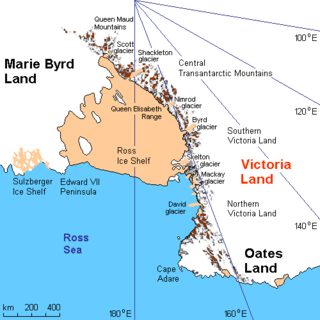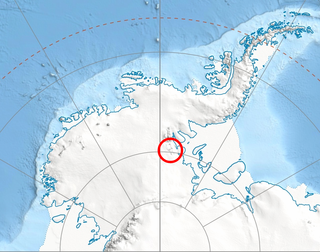The Reedy Glacier is a major glacier in Antarctica, over 100 nautical miles long and 6 to 12 nautical miles wide, descending from the polar plateau to the Ross Ice Shelf between the Michigan Plateau and Wisconsin Range in the Transantarctic Mountains. It marks the limits of the Queen Maud Mountains on the west and the Horlick Mountains on the east.
The Britannia Range is a range of mountains bounded by the Hatherton Glacier and Darwin Glacier on the north and the Byrd Glacier on the south, westward of the Ross Ice Shelf in Antarctica.
The Cook Mountains is a group of mountains bounded by the Mulock and Darwin glaciers in Antarctica. They are south of the Worcester Range and north of the Darwin Mountains and the Britannia Range.

The Walker Mountains are a range of peaks and nunataks which are fairly well separated but trend east–west to form the axis, or spine, of Thurston Island in Antarctica.

The Scott Glacier is a major glacier, 120 nautical miles long, that drains the East Antarctic Ice Sheet through the Queen Maud Mountains to the Ross Ice Shelf. The Scott Glacier is one of a series of major glaciers flowing across the Transantarctic Mountains, with the Amundsen Glacier to the west and the Leverett and Reedy glaciers to the east.
The Hays Mountains are a large group of mountains and peaks of the Queen Maud Mountains of Antarctica, surmounting the divide between the lower portions of Amundsen Glacier and Scott Glacier and extending from the vicinity of Mount Thorne on the northwest to Mount Dietz on the southeast.
The Mariner Glacier is a major glacier over 60 nautical miles long, descending southeast from the plateau of Victoria Land, Antarctica, between Mountaineer Range and Malta Plateau, and terminating at Lady Newnes Bay, Ross Sea, where it forms the floating Mariner Glacier Tongue.

Young Glacier is a glacier which flows from Mount Gozur and Ichera Peak in Maglenik Heights eastwards for 8 miles (13 km) and terminates at the north end of Barnes Ridge on the east side of Sentinel Range, Ellsworth Mountains in Antarctica. It was first mapped by the United States Geological Survey (USGS) from surveys and U.S. Navy air photos from 1957–59. It was named by the Advisory Committee on Antarctic Names (US-ACAN) for First Lieutenant Dale L. Young of the United States Air Force (USAF), who participated in establishing the South Pole Station in the 1956–57 season.
Windy Cove is a small bay entered 0.6 nautical miles (1.1 km) southeast of Antarctic Point on the north coast of South Georgia. The bay was named Whatahope Bay, probably by DI personnel who charted this coast in 1929, but is known locally as Windy Cove. It is probable that this latter name, originally given by DI personnel in 1929 to the next bay to the northwest, was erroneously transferred to this feature. Since Whatahope Bay is unknown locally, the name Windy Cove as applied to this feature is approved.
Mount Aldrich is a massive, somewhat flat-topped mountain standing at the east side of Ragotzkie Glacier in the Britannia Range, Antarctica.
The Gothic Mountains is a group of mountains, 20 nautical miles long, in the Queen Maud Mountains of Antarctica, located west of Watson Escarpment and bounded by Scott Glacier, Albanus Glacier, and Griffith Glacier.
Neuburg Peak is a jagged rock peak in Antarctica, 1,840 metres (6,040 ft) high, rising 2.5 nautical miles east of Walker Peak in the southwest part of Dufek Massif, Pensacola Mountains.
Watson Escarpment is a major escarpment in the Queen Maud Mountains, trending northward along the east margin of Scott Glacier, then eastward to Reedy Glacier where it turns southward along the glacier's west side. Somewhat arcuate, the escarpment is nearly 100 nautical miles long, rises 3,550 metres (11,650 ft) above sea level, and 1,000 to 1,500 metres above the adjacent terrain.

Webster Glacier is a glacier in the Founders Peaks of the Heritage Range, flowing generally north between Frazier Ridge and Pipe Peak to enter Minnesota Glacier. Mapped by United States Geological Survey (USGS) from surveys and U.S. Navy air photos, 1961–66. Named by Advisory Committee on Antarctic Names (US-ACAN) for Charles W. Webster, United States Antarctic Research Program (USARP) meteorologist and member of the winter party at Wilkes Station in 1963.
Craig Ridge is a small rock ridge located close northeast of Polarstar Peak in the Sentinel Range, Ellsworth Mountains. It was named by the University of Minnesota Geological Party to these mountains, 1963–64, for James A. Craig, a helicopter crew chief with the 62nd Transportation Corps Detachment, who assisted the party. The geological party found a fossil leaf of the plant Glossopteris on the ridge.
Ford Massif is a broad, snow-topped massif 15 nautical miles long and 5 nautical miles wide, forming the major topographic landmark of the northern Thiel Mountains in Antarctica. The massif rises to 2,810 metres (9,220 ft), is essentially flat, and terminates in steep rock cliffs in all but the southern side.
The Founders Peaks are a cluster of sharp peaks and ridges located just east of Founders Escarpment and between Minnesota Glacier and Gowan Glacier, in the Heritage Range of the Ellsworth Mountains in Antarctica. The peaks were mapped by the United States Geological Survey from surveys and U.S. Navy air photos, 1961–66. The name was applied by the Advisory Committee on Antarctic Names is association with the name Heritage Range.
Tornquist Bay is a small bay between Cape Constance and Antarctic Point along the north coast of South Georgia. Charted in 1929-30 by DI personnel, who called it Windy Cove, because of strong gusts of wind experienced there, but the name Windy Hole was subsequently used on charts for the bay. Following a survey of South Georgia in 1951–52, the SGS reported that this feature is known to the whalers and sealers as Tornquist Bay, because the wreck of the Cape Constance on October 16, 1950, lies near its west shore. This latter name is approved on the basis of local usage; the name Windy Hole is never used locally. The name Windy Cove, originally applied to this bay, has been transferred in local usage to the bay immediately southeast of Antarctic Point and it has since become established there.
Holt Peak is a bare rock peak, 850 metres (2,800 ft) high, surmounting the northeast end of the Meyer Hills in the Heritage Range of Antarctica. It was mapped by the United States Geological Survey from surveys and U.S. Navy air photos from 1961 to 1966, and was named by the Advisory Committee on Antarctic Names for William C. Holt, a United States Antarctic Research Program auroral scientist at Ellsworth Station in 1961.
The Allegheny Mountains are a small group of mountains 10 nautical miles west of the Clark Mountains in the Ford Ranges of Marie Byrd Land, Antarctica.
![]() This article incorporates public domain material from "Windy Peak (Antarctica)". Geographic Names Information System . United States Geological Survey.
This article incorporates public domain material from "Windy Peak (Antarctica)". Geographic Names Information System . United States Geological Survey. 


